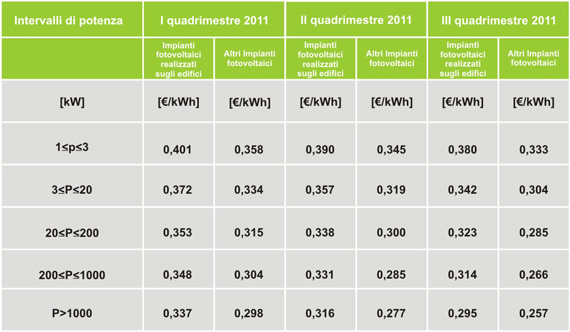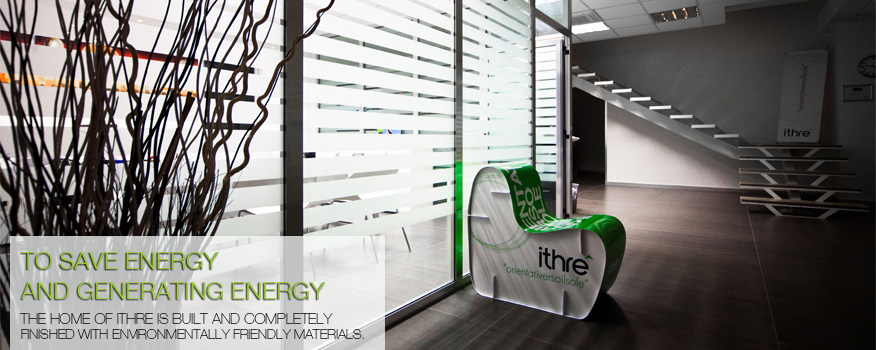|
|
INFOTOVOLTAICO

Today it's possible to help the environment with good earning potential. Just install a photovoltaic system and take advantage of government incentives provided by the Energy Account.
PHOTOVOLTAIC
PV systems are measured in kilowatts peak. Renewable energy are characterized by having a abundant potential, being theoretically unlimited, but also from being intermittent.When the wind doesn't blow,the blades of a windmill languishing helplessly. The same way in the dark,for example at night,no matter how big is your solar farm: no electricity.
The rated power is defined peak for this reason: it is the maximum output power in ideal conditions.
But how? So if I install a photovoltaic system at night I'm in the dark?
-
No: let me explain!
In most cases,a photovoltaic system is grid-connected, that is directly connected to the mains.
This means that you become a real power producer:clean energy that you paid (the community thanks you for this) is made available to the world, and recorded by a counter.
The same way, you still withdraw the electricity that you need through your usual supplier.Now, if you use your energy for your household consumption at the same time when this is produced by your PV system, that is during the day and the sun, the same you will not be accounted for in the bill from your provider.
If you consume energy in the absence of sunlight, you'll receive regular bi-monthly bill which will then be refunded excluding the costs of dispatching. But I'll tell you best friend: If you are not registered for VAT, you will be fully refunded.
And if my system produces more of my energy needs?
Simple answer: the excess kilowatt will undertake a credit at your disposal to use for the duration of your system each time your consumption will be higher than Kilowattora produced by your system.Therefore, with this mechanism called "net metering", a photovoltaic system makes you first save on the cost of electricity, because you can avoid buying one that already produce, own consumption.
Your energy supplier for you accumulate any surplus energy produced but not consumed.
How do you know how much electricity it produces a photovoltaic system?
Obviously it depends on how much sunlight falls annually at the installation site.
Sounds complicated but is actually very simple: by ENEA are maps showing the monthly average values of solar radiation daily for over 2000 Italian municipalities, estimated from satellite images of cloud cover for several years until 1999.
So we can calculate,with great accuracy, the annual production of electricity of individual photovoltaic installation. We know for example that in a small town between Naples and Salerno, a plant 1KwP is capable of producing 1350 kilowatts each year. Consequently a plant 3KwP will produce about 4050 and so on.
Okay. But the incentives? Follow me, the best is still to come.
ENERGY BILL
To be able to cut down carbon dioxide emissions as required by the Kyoto Protocol, the European Union has imposed Italy aims to reach 1200 megawatts of energy produced from solar by 2012.
To get this result we had to copy the model of incentive which had worked in Germany, which is,uptoday, the most virtuous nation in this area.
This model, resulting in the so-called Energy Bill, entered into force with the Ministerial Decree of February 19, 2007, and that the state provides incentives for the production of electricity for 10 years, focusing on plants and those little ones with a lower architectural impact, according to the following table::

For example, the energy bill recognizes some 47 euro cents per kilowatt hour produced, for those who have built a plant 3KwP and integrate it with roof replacing the original covering.
Means to receive € 1903,50 for year, ie € 38.070 in total.
However, if the plant is resting on the roof in a coplanar, the state pays a little less: 42 eurocents for kilowatt hour. Not bad anyway: this means 1709 € in twelve months.
Then if you have an old roof and you have to dispose of asbestos, the ultimate solution is to install a photovoltaic system. In fact, an additional 5% is recognized in addition to the above rates.
Fantastic, it would definitely repay the replacement of all the coverage!
EXAMPLE
Well.Now we have all the elements to understand how we can save the world making a nice profit! We take the average case. We have a roof on which we make a photovoltaic system supported in a coplanar, with a power of 2.9 kWp. why not 3KwP ? because 3KwP will not be possible. I have not said that for every KwP it takes about 8 square meters.
Well, I tell you now. 2.9 kilowatt peak now, make 3915 kWh per year.
Yes, ok! But how much will it cost?.
Well, almost ... more or less ... let's say 17500 € between costs of design, photovoltaic modules, wiring, inverters, accessories, cost of site .. 10% VAT included.
And if a person does not have all this money? Calm: don't worry.
Some companies have entered into cooperation agreements with banks, arriving in some cases not to apply for advance and charge the rate of the loan only when the system is properly put into operation and start earning cash.
Of course: making it clear that no one prevents us from buying the system with our money.
If we get an offer we will have a similar plan 15 years with annual installments of € 1715 , which we will start to pay only when we will start to collect.
Then € 1715 only the first year.Well: what makes our system in a year? Simple: 3915 kWh (the energy produced in 12 months) * € 0,403 (government incentives), to which should be added 3915 * € 0.19 (the price of the kilowatt hours that we will not be forced to buy).
Let me some up: in total 1577.74 +743.85 = € 2321.59. Two thousand three hundred and twenty-one EUR and 59 cents are more than the amount of mortgage payment above: to be precise I gained € 606.59! I have installed a PV system, I have not spent anything and I have earned € 606.59 only in the first year. Then in 15 years I have gained a total revenue of EUR 9098.85
I invite you to consider that the annual revenue will be even more significant because, while the mortgage payment remains constant, the electricity costs are rising.
Not only: you keep in mind that after 15 years, having paid off the mortgage, the annual income will pay the entire sum of EUR 2321.59 which is determined by incentive+savings in the bill, of which I mentioned earlier, bringing the total gain in 20 years more than twenty-one thousand EUR.
In short, not bad for having avoided at least 40 tons of carbon dioxide, have reassessed our property and not have spent anything, don't you think so?
And after 20 years what happens? Energy account ceases to boost our energy production, but the plant remains in operation and, although it is expected a slight decline in physiological performance of the conversion, it will continue to give us free energy, making us even save for many years to come.
We have also included maintenance and insurance for a small additional charge which will be absorbed by the plant output.
Insurance may cover it all: direct, indirect damages, appeals neighbors and / or third parties, weather, and even the economic damage resulting from an unexpected stop of the system, with compensation for lost government incentives.
CONCLUSIONS
The most common question at this point is: Well,but why don't everybody do it? They are doing it all.
But you have to hurry: first because the incentives will be re-evaluated to reach the 1,200-megawatt installation, and secondly because the incentives on new plants will be reduced by 2% every year.
It does not appear, but it is a lot of money: better to start work immediately, so that the plant is completed soon.
If you're intrigued beyond all limits, there are many online resources that can help you, starting with the site Manager of Energy Services, GSE SpA, which is the organ with which you enter into contracts to encourage twenty years and whose only member is the Ministry of Economy and Finance
But if you need to improve your knowledge,please write to:info@ithre.it.
|
|


